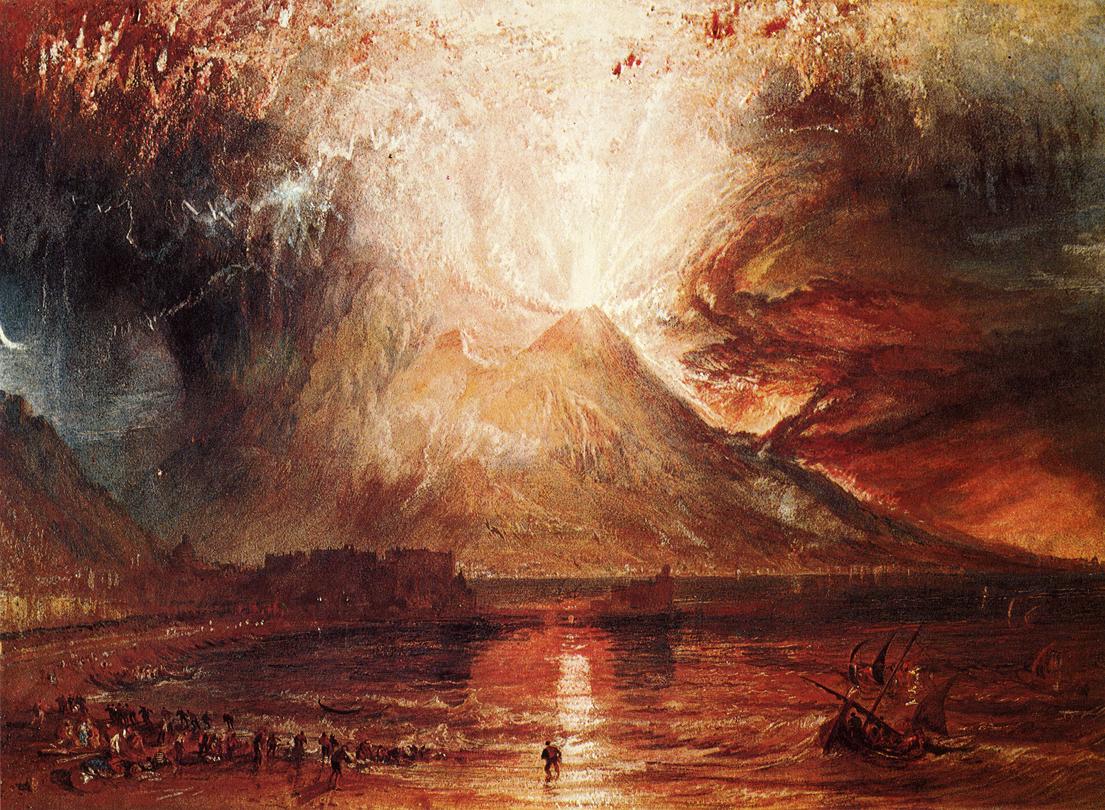In Proust’s Swann’s Way, the narrator’s grandmother is described as one who
inculcates in her grandson a reverence for the “elevated ideals.” Infinitely
disdainful of the mechanical nature of replica, when shown photograph of the
magnificent Mount Vesuvius his grandmother dismisses it with a lofty query as
of whether other more acknowledged artists did paintings of the volcano in the
first place. She is having in mind the great J.M.W. Turner, whose depiction of
Vesuvius in flame displays, in her view, “a stage higher in the scale of art.”
The enduring fascination with volcanoes was
especially evident in the 19th century, which saw an irregularly
high frequency of Vesuvius eruptions that, at the time, alarmed many of the
imminent cataclysm that a thousand of years before destroyed the city of
Pompeii. Turner, according to a number of sources, may not be amongst the
first-hand witnesses of those eruptions, but badgered his geologist friends,
John MacCulloch and Charles Stokes, for scientific knowledge of the phenomena.
As such, Turner’s sketchbooks are full of detailed records and drawings of
Vesuvius, on the strength of which he was said to make his bewildering
depiction of the erupting volcano. In it, the shimmering colours and the brisk
brushwork culminate in a glorious symphony that possesses of a quality of, what
Yeats would call, the “terrible beauty.” Turner succeeds in embodying with this
painting the “thickness” of art, a virtue the grandmother in Swann’s determines as a supremacy
exclusive to high art, distinguishing it from other vulgar, banal commodities
that clutter up our daily existence.
Of what is
vulgar and what is beautiful can be measured in various ways. As early as the
13th century Italy, philosophers were already suggesting the volatile
nature of beauty. Modifying on the old conception that beauty is only permitted
if according with the dictates of moral goodness, Thomas Aquinas asserted: “The
good is that towards the possession of which an appetite tends.” What is good
depends on what one’s appetite decides, i.e. what one desires of, a sentiment
that should be governed solely by one’s individual self, without the unduly
interference from outward influence. Though not saying if beauty also
encompasses aspects that are not morally acceptable, many would later interpret
Aquinas’s argument as premonitory of a new trend of thought, that of “the
beauty of ugliness.”
Not exactly
an ugly painting but neither is it traditionally beautiful, Turner’s Vesuvius Erupting (1817) is a perfect
example of creating beauty whilst sacrificing the old ideals. The figures are
sketchy, the brushstrokes are rough, the colours go pell-mell as if they were
spurted onto the canvas from a tube- and yet the result is spontaneous and, not
many would disagree, captivating. History has testified to the well-exercised lesson
that no value is definitive or immutable; even a canonic work is obliged to
undergo the tests of every succeeding age to justify its uniqueness.

Bathilde makes a great point in this part of the book. Both photography and painting have their perks and downsides but painting has more opportunity with which you can interpret a subject widely different than a photograph which is simply the moment captured on film. Turner’s painting is very lovely btw. She also mentions Hubert Robert’s Fountains as another example of a painting surpassing its subject matter.
ReplyDeleteThanks and that i have a keen proposal: Whole House Renovation Cost Calculator house renovation
ReplyDelete